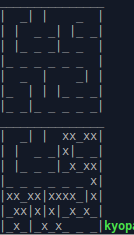a maze solver in C.
I have not included the maze generation code because i'm not looking for a review on that in this post, but the maze solver operates on a 1D array of cells, for more info: Maze generation algorithm review
Sample run:
Bottom left is the starting point (0, 6) Top right is the ending point (6, 0)
solve.c
#include "../struct.h"
#include "../maze.c"
#include "../cell.c"
#include <stdio.h>
#include <stdlib.h>
bool topwall(Maze *maze, point *p);
bool botwall(Maze *maze, point *p);
bool leftwall(Maze *maze, point *p);
bool rightwall(Maze *maze, point *p);
bool equal(point p, point p2);
void solve(Maze *maze, point p, point e) {
static bool found = false;
if (found) return;
if (equal(p, e)) {
found = true;
}
(*cell_at(maze, p.x, p.y)).visited = true;
point temp;
if (p.x < (colMAX - 1) && !rightwall(maze, &p) && !is_visited(maze, p.x + 1, p.y)) {
temp = p;
temp.x++;
solve(maze, temp, e);
}
if (p.x > 0 && !leftwall(maze, &p) && !is_visited(maze, p.x - 1, p.y)) {
temp = p;
temp.x--;
solve(maze, temp, e);
}
if (p.y > 0 && !topwall(maze, &p) && !is_visited(maze, p.x, p.y - 1)) {
temp = p;
temp.y--;
solve(maze, temp, e);
}
if (p.y < (rowMAX - 1) && !botwall(maze, &p) && !is_visited(maze, p.x, p.y + 1)) {
temp = p;
temp.y++;
solve(maze, temp, e);
}
if (found) {
(*cell_at(maze, p.x, p.y)).path = true;
}
return;
}
bool equal(point p, point p2) {
return (p.x == p2.x && p.y == p2.y);
}
bool rightwall(Maze *maze, point *p) {
return (*cell_at(maze, p->x, p->y)).right_wall;
}
bool leftwall(Maze *maze, point *p) {
return (*cell_at(maze, p->x - 1, p->y)).right_wall;
}
bool botwall(Maze *maze, point *p) {
return (*cell_at(maze, p->x, p->y)).bottom_wall;
}
bool topwall(Maze *maze, point *p) {
return (*cell_at(maze, p->x, p->y - 1)).bottom_wall;
}
cell.c
#ifndef C
#define C
#include "struct.h"
#include <stdbool.h>
cell *cell_at(Maze *maze, size_t x, size_t y) {
return &maze->cells[x + y * maze->width];
}
bool is_visited(Maze *maze, size_t x, size_t y) {
return (*cell_at(maze, x, y)).visited;
}
#endif
main.c
#include <stdio.h>
#include "generate/generate.c"
#include "solve/solve.c"
#include "maze.c"
int main(int argc, char *argv[]) {
srand(time(0));
if (argc == 1) {
colMAX = rowMAX = 7; // default
} else colMAX = rowMAX = (atoi(argv[2]));
stack = malloc((rowMAX * colMAX) * sizeof(point));
Maze maze = {colMAX, rowMAX, malloc(rowMAX * colMAX)};
initcells(&maze);
point p = {0, 0};
push(p);
while (sp > 0) {
generatemaze(&maze);
}
printmaze(&maze);
putchar('\n');
cell* cellptr = maze.cells;
for (int i = 0; i < (rowMAX * colMAX); ++i) {
cellptr->path = false; // reset
cellptr++->visited = false;
}
point s = {0, 1}; // custom starting / end point not yet implemented
point e = {6, 0};
solve(&maze, s, e);
printmaze(&maze);
return 0;
}
struct.h
#ifndef H
#define H
#include <stddef.h>
typedef struct cellstruct {
bool bottom_wall: 1;
bool right_wall: 1;
bool visited: 1;
bool path: 1;
} cell;
typedef struct mazestruct {
size_t width;
size_t height;
cell *cells;
} Maze;
typedef struct {
size_t x;
size_t y;
} point;
typedef enum {
LEFT,
RIGHT,
TOP,
BOTTOM
} direction;
#endif


visited = trueon enteringsolve- you should reset it to false on leaving \$\endgroup\$